
Martin of Tours, also known as Martin the Merciful, was the third bishop of Tours. He has become one of the most familiar and recognizable Christian saints in France, heralded as the patron saint of the Third Republic, and is patron saint of many communities and organizations across Europe. A native of Pannonia, he converted to Christianity at a young age. He served in the Roman cavalry in Gaul, but left military service at some point prior to 361, when he became a disciple of Hilary of Poitiers, establishing the monastery at Ligugé. He was consecrated as Bishop of Caesarodunum (Tours) in 371. As bishop, he was active in the suppression of the remnants of Gallo-Roman religion, but he opposed the violent persecution of the Priscillianist sect of ascetics.

Advent is a season observed in most Christian denominations as a time of expectant waiting and preparation for both the celebration of the Nativity of Christ at Christmas and the return of Christ at the Second Coming. Advent is the beginning of the liturgical year in Western Christianity. The name was adopted from Latin adventus "coming; arrival", translating Greek parousia from the New Testament, originally referring to the Second Coming.

Martial, called "the Apostle of the Gauls" or "the Apostle of Aquitaine", was the first bishop of Limoges. His feast day is 30 June.

Saint Finbar, Finbarr, Finnbar, or Finnbarr, in Irish Fionnbharra, very often abbreviated to Barra, was Bishop of Cork and abbot of a monastery in what is now the city of Cork, Ireland. He is patron saint of the city and of the Diocese of Cork. His feast day is 25 September.
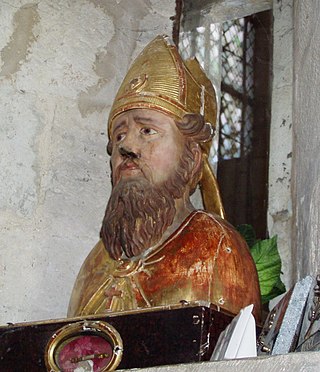
SulpitiusII. the Pious was a 7th-century bishop of Bourges and saint.
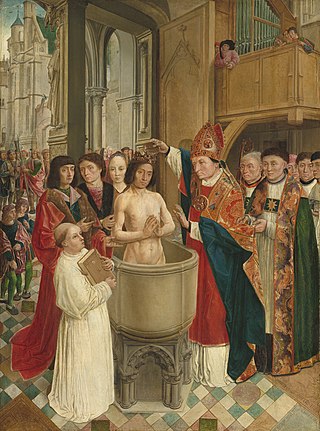
Remigius was the Bishop of Reims and "Apostle of the Franks". On 25 December 496, he baptised Clovis I, King of the Franks. The baptism, leading to about 3000 additional converts, was an important event in the Christianization of the Franks. Because of Clovis's efforts, a large number of churches were established in the formerly pagan lands of the Frankish empire, establishing a distinct Catholic variety of Christianity for the first time in Germanic lands, most of whom had been converted to Arian Christianity.
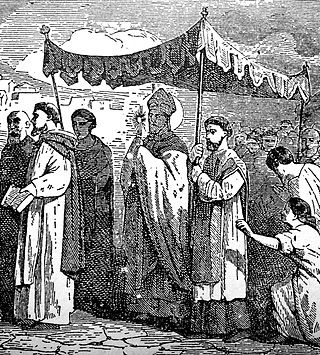
Mamertus was the bishop of Vienne in Gaul, venerated as a saint. His primary contribution to ecclesiastical practice was the introduction of litanies prior to Ascension Day as an intercession against earthquakes and other disasters, leading to "Rogation Days." His feast day is the first of the Ice Saints.
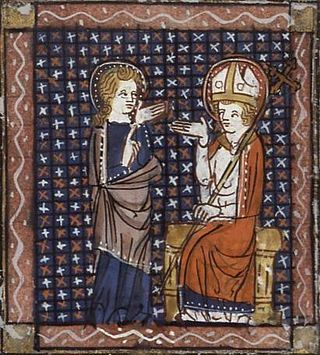
Brice of Tours was a 5th-century Frankish bishop, the fourth Bishop of Tours, succeeding Martin of Tours in 397.

Medardus or Medard was the Bishop of Noyon. He moved the seat of the diocese from Vermand to Noviomagus Veromanduorum in northern France. Medardus was one of the most honored bishops of his time, often depicted laughing, with his mouth wide open, and therefore he was invoked against toothache.

Merovingian art is the art of the Merovingian dynasty of the Franks, which lasted from the 5th century to the 8th century in present-day France, Benelux and a part of Germany. The advent of the Merovingian dynasty in Gaul in the 5th century led to important changes in the field of arts. Sculptural arts consisted of the ornamentation of sarcophagi, altars and ecclesiastical furniture. Gold work and the new medium of manuscript illumination integrated "barbarian" animal-style decoration, with Late Antique motifs, and other contributions from as far as Syria or Ireland to constitute Merovingian art.

The Archdiocese of Lyon, formerly the Archdiocese of Lyon–Vienne–Embrun, is a Latin Church metropolitan archdiocese of the Catholic Church in France. The archbishops of Lyon serve as successors to Saints Pothinus and Irenaeus, the first and second bishops of Lyon, respectively, and are also called primates of Gaul. He is usually elevated to the rank of cardinal. Bishop Olivier de Germay was appointed archbishop on 22 October 2020.
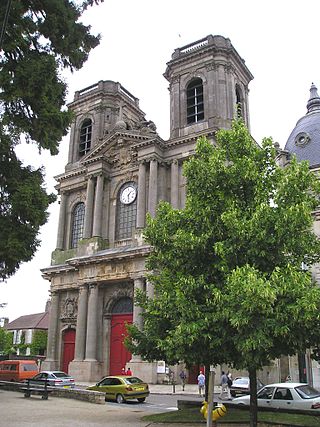
The Diocese of Langres is a Latin Church diocese of the Catholic Church comprising the département of Haute-Marne in France.

Symphorian, Timotheus (Timothy), and Hippolytus of Rome are three Christian martyrs who, though they were unrelated and were killed in different places and at different times, shared a common feast day in the General Roman Calendar from at least the 1568 Tridentine Calendar to the Mysterii Paschalis. While still a young man, Symphorian was either beheaded or beaten to death with clubs.

Saint Gaugericus, in French Saint Géry was a bishop of Cambrai, France.
Saint Viventiolus was the Archbishop of Lyon 514–523. Later canonized and venerated as a saint within the Catholic Church, Archdiocese of Lyon, France his feast Day is July 12. He is recognised in the Orthodox Church and the True Orthodox Church, including amongst the Tikhonites, as a pre-Great Schism Western Saint.
Auspicius of Toul was a 5th-century bishop of Toul, the fifth of those recorded, and a saint of the Roman Catholic church. He was also a poet, known for iambic verse based on stress ; this was an innovation of his time. A verse letter of his from around 470 to Arbogast, count of Trier, survives.

Aignan or Agnan (358–453), seventh Bishop of Orléans, France, assisted Roman general Flavius Aetius in the defense of the city against Attila the Hun in 451. He is known as Saint Aignan.
Lawrence I was Archbishop of Milan from 490 to c. 511. He is honoured as a saint in the Catholic Church and his feast day is July 25.

Ourense Cathedral is a Roman Catholic church located in Ourense in northwestern Spain. Dedicated to St Martin, it was founded in 550. The first structure was restored by Alonso el Casto. The present mainly Gothic building was raised with the support of Bishop Lorenzo in 1220. Its local patroness is Saint Euphemia. There is a silver-plated shrine, and others of St Facundus and St Primitivus. The Christ's Chapel was added in 1567 by Bishop San Francisco Triccio. It contains an image of Christ, which was brought in 1330 from a small church on Cape Finisterre. John the Baptist's Chapel was created in 1468 by the Conde de Benavente. The Portal of Paradise is sculptured and enriched with figures of angels and saints, while the antique cloisters were erected in 1204 by Bishop Ederonio. The Capilla de la Maria Madre was restored in 1722, and connected by the cloisters with the cathedral. The eight canons were called Cardenales, as at the Cathedral of Santiago de Compostela, and they alone did services before the altar; this custom was recognised as "immemorial" by Pope Innocent III, in 1209. The cathedral, which has undergone an impressive transition of architectural styles of Romanesque, Gothic, Renaissance, Baroque and Neoclassical, was built to a Latin Cross plan. It has been a functional basilica since 1887. The cathedral has a crucifix that is held in great reverence all over Galicia.

Saint Euphronius of Autun was a bishop of Autun between 450 and 490. According to Dom Basil Watkins OSB, Euphronius "was one of the greatest bishops of Gaul..."in the 5th century.

















